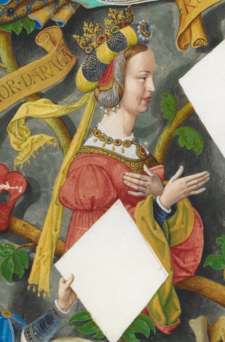Eleanor of Alburquerque
| Eleanor of Alburquerque | |
|---|---|
 | |
| Queen consort of Aragon | |
| Tenure | 3 September 1412 – 2 April 1416 |
| Born | 1374 Aldeadávila de la Ribera |
| Died | 16 December 1435 (aged 60) Medina del Campo |
| Burial | |
| Spouse | Ferdinand I of Aragon |
| Issue | Alfonso V of Aragon Maria, Queen of Castile John II of Aragon Henry of Aragon, Duke of Villena Eleanor, Queen of Portugal Pedro of Aragon, Count of Alburquerque Sancho of Aragon |
| House | Trastámara |
| Father | Sancho Alfonso |
| Mother | Beatrice of Portugal |
| Religion | Roman Catholicism |

Eleanor, 3rd Countess of Alburquerque (1374 – 16 December 1435) became Queen consort of Aragon by her marriage to Ferdinand I of Aragon. In Spanish, she is known as Leonor Urraca de Castilla, condesa de Alburquerque.
Family
Her father was Sancho Alfonso, 1st Count of Alburquerque, who was an illegitimate son of King Alfonso XI of Castile[1] and his mistress Eleanor of Guzman, and a brother of King Henry II of Castile. Her mother was Infanta Beatrice, Countess of Alburquerque, who was daughter of Peter I of Portugal and Ines de Castro.[1] Eleanor was born in Aldeadavila de la Ribera, now in National Park since 2002 of Arribes del Duero Natural Park, province of Salamanca.
Eleanor's brother was Ferdinand, 2nd Count of Alburquerque.
Marriage
Eleanor was originally betrothed to Frederick, illegitimate son of Henry II of Castile, however this engagement was broken off.
Upon the death of the sickly John I of Castile on October 9 of 1390 the Regency Council addressed the issue of the heir presumptive, Infante Henry at the time eleven years of age and his brother Infante Ferdinand, who was then ten years. It was agreed that Ferdinand could not marry before his brother Henry reached the age of fourteen. Then he would be granted the privileges and social policies majority.
Peter I of Castile was murdered in March 1369 by his bastard brother Henry. The representatives of the clergy, the nobility, the state of the gentry and merchants, as well as the authorized legal representatives of some Castillian cities agreed that Henry's grandson Infante Henry should marry the granddaughter of the murdered Peter, the English princess Catherine of Lancaster, daughter of John of Gaunt. As the elder brother, Henry, fulfilled these requirements then so should his brother Infante Ferdinand, with a good wife who was honorable and rich.
It was then heard that Eleanor of Alburquerque was sixteen and old enough to marry. She expressed her agreement in marriage but could not take place as Ferdinand was not yet ten years old. She owned the towns of Haro, Briones, Vilforado, Ledesma with the five towns, Albuquerque, the Codesera, Azagala, Alconchel, Medellin, Alconétar and Villalon, a gift from John I of Castile. This made Eleanor a very attractive offer to Ferdinand.
In 1394, Eleanor and Ferdinand were married. They had seven children:
- Alfonso V of Aragon (1394–1458), also king of Sicily and Naples[2]
- Maria of Aragon, first wife of John II of Castile, (1396–1445)
- John II of Aragon (1397–1479)[1]
- Henry of Aragon, Duke of Villena, Count of Alburquerque,[1] Count of Empuries and Grand Master of the Order of Santiago (1400–1445)
- Eleanor of Aragon (Queen of Portugal), who married Edward I of Portugal, (1402–1445)
- Pedro of Aragon, Count of Alburquerque and Duke of Noto (1406–1438)
- Sancho of Aragon (1410–March 1416). Created Grand Master of the Orders of Calatrava and Alcántara after 1412.
Later life
In 1412, Ferdinand and Eleanor became King and Queen of Aragon after the Compromise of Caspe. However they reigned for only four years, when Ferdinand died in 1416, aged 36 years. Eleanor, who was then 42 years old, retired to Medina del Campo. In 1435 her sons, the princes of Aragon were taken prisoners of the Genoese after the naval battle of Ponza.
The Royal Palace of Medina del Campo, birthplace of her husband and her children, was transformed into the Convent of Santa María la Real. There, Eleanor witnessed her children fighting against the royalist party led by Álvaro de Luna.[3] Eleonor lost some of her possessions as a benefit for the latter.
Eleanor died in Medina del Campo, province of Valladolid, in 1435. Her grave is in the Convent of Santa María la Real, in a simple grave on the floor. It has a tablet that is stone Toledo dark, with the Royal Arms carved on it.
Ancestors
| Ancestors of Eleanor of Alburquerque[4][better source needed] | |||||||||||||||||||||||||||||||||||||||||||||||||||||||||||||||||||||||||||||||||||||||||||||||||||||||||||||||||||||||||||||||||||||||||||||||||||||||||||||||||||||||||||||||||||||||||||||||||||||||||||||||||||||||||||||||||||||||||||||||||||||||||||||||||||||||||||||||||||||||||
|---|---|---|---|---|---|---|---|---|---|---|---|---|---|---|---|---|---|---|---|---|---|---|---|---|---|---|---|---|---|---|---|---|---|---|---|---|---|---|---|---|---|---|---|---|---|---|---|---|---|---|---|---|---|---|---|---|---|---|---|---|---|---|---|---|---|---|---|---|---|---|---|---|---|---|---|---|---|---|---|---|---|---|---|---|---|---|---|---|---|---|---|---|---|---|---|---|---|---|---|---|---|---|---|---|---|---|---|---|---|---|---|---|---|---|---|---|---|---|---|---|---|---|---|---|---|---|---|---|---|---|---|---|---|---|---|---|---|---|---|---|---|---|---|---|---|---|---|---|---|---|---|---|---|---|---|---|---|---|---|---|---|---|---|---|---|---|---|---|---|---|---|---|---|---|---|---|---|---|---|---|---|---|---|---|---|---|---|---|---|---|---|---|---|---|---|---|---|---|---|---|---|---|---|---|---|---|---|---|---|---|---|---|---|---|---|---|---|---|---|---|---|---|---|---|---|---|---|---|---|---|---|---|---|---|---|---|---|---|---|---|---|---|---|---|---|---|---|---|---|---|---|---|---|---|---|---|---|---|---|---|---|---|---|---|---|---|---|---|---|---|---|---|---|---|---|---|---|---|---|---|---|
| |||||||||||||||||||||||||||||||||||||||||||||||||||||||||||||||||||||||||||||||||||||||||||||||||||||||||||||||||||||||||||||||||||||||||||||||||||||||||||||||||||||||||||||||||||||||||||||||||||||||||||||||||||||||||||||||||||||||||||||||||||||||||||||||||||||||||||||||||||||||||
References
- ^ a b c d Earenfight 2015, p. 142.
- ^ Earenfight 2015, p. 143.
- ^ "Aragonese Encyclopedia". Archived from the original on 2016-07-08. Retrieved 2010-07-22.
- ^ de Sousa, Antonio Caetano (1735). Historia genealogica da casa real portugueza [Genealogical History of the Royal House of Portugal] (in Portuguese). Vol. 2. Lisboa Occidental. p. 497.
Sources
- Earenfight, Theresa (2015). "Trastamara Kings, Queens, and the Gender Dynamics of Monarchy". In Todesca, James (ed.). The Emergence of León-Castile c.1065-1500: Essays Presented to J.F. O'Callaghan. Ashgate. p. 141-160.
{{cite book}}: Invalid|ref=harv(help)
Further reading
- 1374 births
- 1435 deaths
- House of Trastámara
- Aragonese queen consorts
- Countesses of Barcelona
- Majorcan queens consort
- Royal consorts of Sicily
- Burials at the Poblet Monastery
- 14th-century Castilians
- 14th-century Spanish women
- 14th-century Italian people
- 14th-century Italian women
- 15th-century people from the Kingdom of Aragon
- 15th-century Spanish women
- 15th-century Italian people
- 15th-century Italian women
